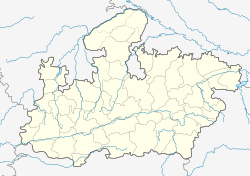Mandu, Madhya Pradesh
|
Mandu माण्डू Mandav |
|
|---|---|
| town | |

Jahaz Mahal
|
|
| Coordinates: 22°20′7″N 75°24′57″E / 22.33528°N 75.41583°ECoordinates: 22°20′7″N 75°24′57″E / 22.33528°N 75.41583°E | |
| Country | India |
| State | Madhya Pradesh |
| Languages | |
| • Official | Hindi |
| Time zone | IST (UTC+5:30) |
| ISO 3166 code | IN-MP |
| Vehicle registration | MP |
Mandu or Mandavgad is a ruined city in the present-day Mandav area of the Dhar district. It is located in the Malwa region of western Madhya Pradesh, India, at 35 km from the Dhar city. In the 11th century, Mandu was the sub division of the Tarangagadh or Taranga kingdom . This fortress town on a rocky outcrop about 100 km (62 mi) from Indore is celebrated for its fine architecture.
An inscription discovered from Talanpur (also in Dhar district) states that a merchant named Chandra Simha installed a statue in a temple of Parshvanatha located in the Mandapa Durga. The word "Mandu" is believed to be a Prakrit corruption of "Mandapa Durga". The inscription is dated 612 VS (555 CE), which indicates that Mandu was a flourishing town in 6th century.
Mandu gained prominence in 10th and 11th century under the Paramaras. The town of Mandu, situated at an elevation of 633 metres (2079 feet), is perched on the Vindhya Range extending for 13 km (8.1 mi) while overlooking the plateau of Malwa to the north and the valley of the Narmada River to the south which acted as natural defences for the fort-capital the Paramaras. As "Mandapa-Durga", Mandu is mentioned as the royal residence in the inscriptions of the Paramara kings starting from Jayavarman II. It is possible that Jayavarman or his predecessor Jaitugi have moved from the traditional Paramara capital Dhara to Mandu, because of attacks of threats of attack from the neighbouring kingdoms. Balban, the general of the Delhi's Sultan Nasir-ud-din, had reached the northern frontier of the Paramara territory by this time. Around the same time, the Paramaras also faced attacks from the Yadava king Krishna of Deogiri and the Vaghela king Visaladeva of Gujarat. Compared to Dhara, which is located in the plains, the hilly area of Mandu would have offered a better defensive position.
...
Wikipedia

